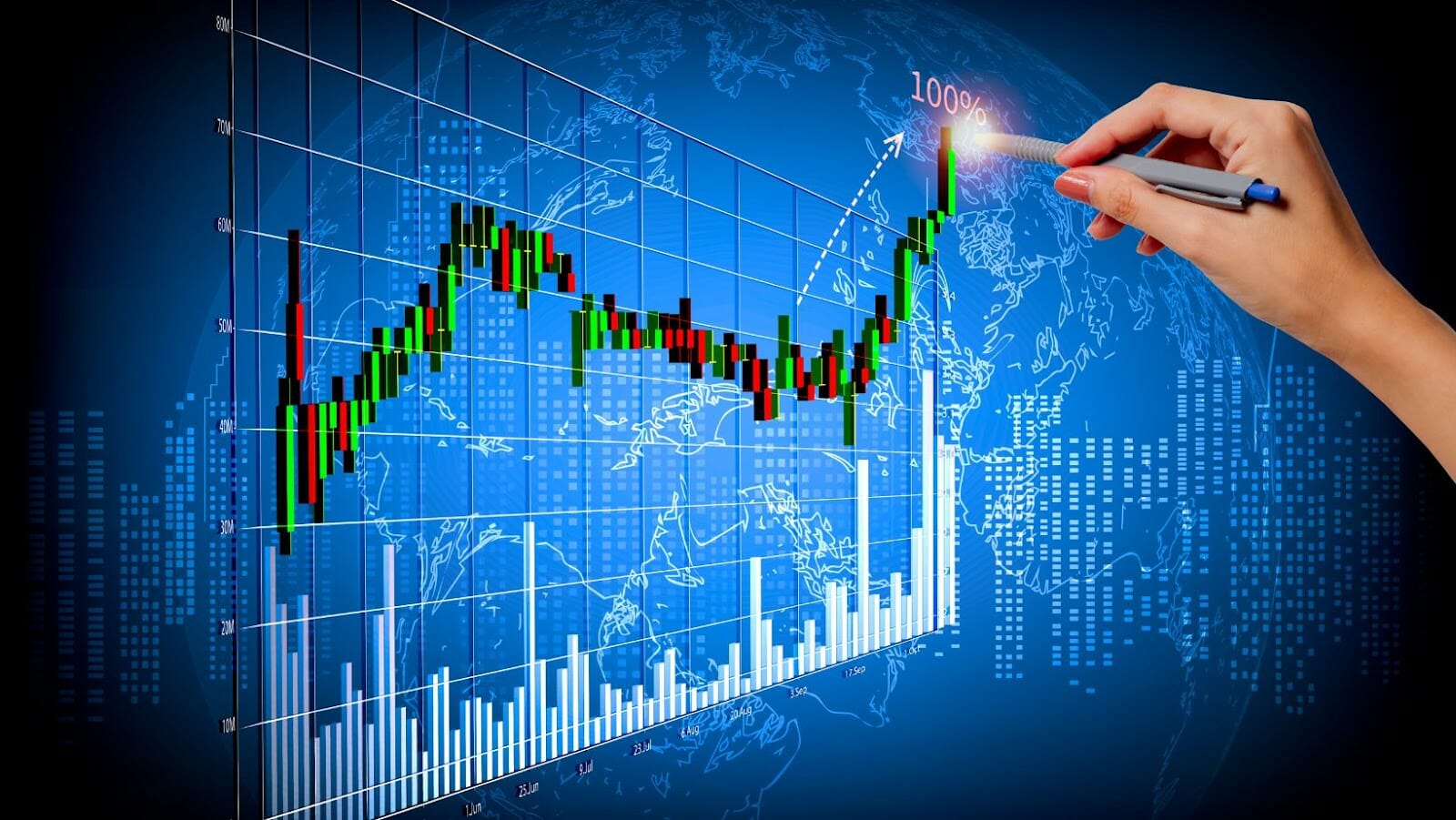Investing and trading can be incredibly lucrative ways to grow your wealth, but they are two very different strategies. While investing involves buying and holding an asset for a longer term to grow its value, trading involves buying and selling assets to profit from short-term price movements.
This article will discuss the differences between investing and trading in more detail.
Investing vs. Trading: What’s the Difference?
Investing is committing money or capital to an endeavour with the expectation of generating an income or profit. Investing always involves some element of risk, as there is no guarantee that your investment will generate a return. In investing, it’s important to consider the potential risks and rewards. Generally speaking, investments are intended to benefit from markets over time (although one can certainly try to make more immediate gains). This means that you don’t try to time a move in and out of a certain stock; rather, you put your money into stocks that you have chosen based on sound research and then wait for returns over the years (sometimes decades), not just days.
Some investors believe they can buy individual stocks with success. Others turn to funds such as actively managed mutual funds or index-tracking exchange traded funds (ETFs). There is another group who pursue other strategies such as options trading or futures contracts where two parties agree on the price for commodities at the future date when delivery is made. Real estate investment can also be popular depending on availability and market conditions. Finally, some investors mix-and-match as well —seeking returns across multiple vehicles — stocks, bonds and so forth — for portfolio diversification purposes.
Definition of trading
Trading is speculating on financial markets to profit from short-term price movements. Most trades are made via brokers, who provide access to these markets and facilitate purchases and sales. Traders use different analysis tools and strategies — such as technical and fundamental analysis — to guide their decision-making when deciding what, when, and how much to buy or sell. Examples of tradable assets include stocks, funds, cryptocurrencies, commodities and foreign currencies.
The main strategy used in trading is active trading — taking advantage of small price movements within a short time frame by using high leverage levels. However, this can be a very risky endeavour because it generally involves large amounts of capital invested in relatively illiquid products – which means they cannot be easily bought or sold with minimal loss incurred from slippage – as well as significant levels of risk tolerance that could make it difficult for investors to cope with potential losses if the market goes against them. High-frequency or multi-chart strategies can push home systems to their limit. A specialized NinjaTrader VPS eliminates performance bottlenecks and provides optimal connectivity, letting you concentrate on refining your edge rather than fighting technical hiccups.
Investment Strategies
Investing and trading are two popular methods used for financial gain. Both involve taking risks and require knowledge and strategy, but they involve different approaches and amounts of money.
This section will explore the key differences between investing and trading.
Buy and hold
The “buy and hold” investment strategy involves the investor acquiring an asset, such as a stock, and then holding onto it for an extended period. The investor will typically look at the long term prospects of the asset, evaluating how it can perform in various economic environments. This strategy is best for conservative investors looking to slowly generate wealth over time.
A key aspect of this strategy is that investors will not actively manage their positions but maintain them passively, only making changes if circumstances warrant it. Of course, this can involve research necessary to stay informed about what’s happening in the markets. Still, for the most part, most buying and holding investments involve very little effort from the investor.
This method can be risky as market forces sometimes upend long-term trends or introduce new risk factors that might have been previously unanticipated. At times such as these, it pays to minimise losses by getting out before they become more severe. However, it also means investors must have enough faith in their judgement to not bail out too early when things turn against them.
Dollar-cost averaging
Dollar-cost averaging (DCA) is an investing strategy that involves regularly buying a fixed dollar amount of a particular investment. This type of approach is favoured by risk-averse investors who prefer to take a more conservative approach than buying all at once.
The idea behind DCA is to purchase investments over time, reducing the “timing risk” associated with investing all at once. When you invest this way, the cost per share averages across your purchases and softens out some of the market volatility because you do not buy too much at one time; instead, your investments are spread evenly over time.
Furthermore, averaging out your entry into the market reduces the chance of having an incorrect decision and entering at an inopportune moment. Ultimately, it gives investors more control over their investments without any drastic responses required during market fluctuation.
Value investing
Value investing is a popular long-term investment strategy focused on buying stocks or other securities below their intrinsic or book value that can potentially create value for the investor over time. Value investors take advantage of stocks that are undervalued and priced lower than their true worth, to profit from a stock’s appreciation (or increase in stock price) over time. By seeking out and investing in companies, whose underlying financials are solid but their stock price has been affected by external factors such as market sentiment, value investors look to profit from long-term capital appreciation.

Unlike day trading, this investment strategy is characterised by patient and diligent research of an asset’s intrinsic value to ensure it presents good long-term potential returns for an investor. Value investors analyse several metrics such as financial statements, market conditions, economic trends, and even shop around for assets whose prices at the current moment may be significantly lower than they should be. In addition, they seek out companies across all industries that show standard valuation metrics like lower price/earnings ratios (P/Es), higher dividend yields, higher return on equity (ROE), etc., signalling that the company may be undervalued to what it might be worth.
Value investors aim to maximise returns by seeking out those buys with greater upside potential than downside risk.
Trading Strategies
Trading and investing are often confused as they have similar goals of making returns. However, investment goals, capital allocation, risk tolerance, and trading strategies differ.
Before deciding on a trading strategy, it is important to understand the key differences between investing and trading. Here, we’ll discuss the differences and explain the various trading strategies.
Day trading
Day trading is a trading strategy where investors make decisions and carry out trades on the same day, buying and selling financial instruments over a short period. Day traders generally do not hold positions overnight, meaning all positions placed during the day are closed before the market closes. This type of trading allows traders to take advantage of market fluctuation and react quickly to price movements.
Day trading involves technical analysis, which uses charting tools to examine market data. Technical analysis attempts to forecast future price movements by looking at past patterns and trends in financial markets. In addition, day traders analyse charts to identify opportunities, such as when certain support or resistance levels are broken that might signal a trend reversal or continuation.
Day traders use various order types – such as stop orders, limit orders and market orders – depending on their strategy and risk tolerance. Traders may also diversify their portfolios by taking long positions (buying) in some securities while shorting (selling) other securities simultaneously to minimise losses or maximise gains. Riskier traders may use margin accounts that allow them to borrow against their investments, allowing them greater exposure than they would otherwise have with cash equity alone.
Swing trading
Swing trading is a strategy that attempts to capture gains in a stock (or any other financial instrument) within an uptrend or downtrend. The trader holds onto the stock, expecting it to move in one direction. Swing traders may hold their stocks anywhere from overnight to several weeks, making it a suitable option for those with limited time for investing activities.
Swing trading is less risky than day trading but more risky than a buy-and-hold strategy. Swing traders must be aware of potential resistance points as they may cause prices to reverse direction abruptly, leading to significant losses. Fundamental and technical indicators can also help swing traders foresee potential moves in the market so that they can adjust positions accordingly and take advantage of opportunities as they arise.
The benefit of swing trading is that it allows traders to capture the trend without sitting in front of their screens all day waiting for an opportunity to arise. Those who are new to the markets may find this strategy useful. At the same time, they develop their skills and knowledge base before progressing into more complex strategies such as day trading or position trading.
Scalping
Scalping is a trading strategy that involves entering and exiting positions on a short-term basis. It is usually applied to smaller stocks, futures, or foreign exchange markets and involves taking advantage of small price movements to make frequent profits. Scalpers typically use technical indicators such as moving averages, stochastics, and relative strength index (RSI). They are also familiar with chart patterns and market tendencies.
Traders who scalp often execute multiple trades daily to capitalise on small price changes throughout the day. This can mean trading dozens of orders or maintaining multiple positions throughout the day until the market closes for the session.
Scalping is one of several short-term investments strategies, with other methods including day trading and swing trading.
Pros and Cons of Investing vs. Trading
Investing and trading are two ways to take advantage of stock and other financial markets. However, they both have their distinct advantages and disadvantages. Therefore, before deciding which option is best for you, it is important to understand the key differences between investing and trading.
This article will cover the advantages and disadvantages of both investing and trading.
Investing: Pros and Cons
When investing your money, two major types of approaches are generally available: investing and trading. Both have advantages and disadvantages, so it’s important to familiarise yourself with the differences between them before deciding which is right for you.

Investing generally involves investing money into assets that appreciate or generate income over time. This could include the stock market, bonds, mutual funds or real estate, just to name a few. The key benefit of investing money is that it allows you to build wealth over a long period and enjoy generous returns on your investments (ROI). On the other hand, potential downsides of investing include needing to wait for growth over a long period and increased risk in certain cases due to inflation or market volatility.
Trading: Pros and Cons
Trading involves buying and selling stocks or other assets more rapidly to make small gains over shorter periods. However, traders must be prepared for more frequent losses due to market volatility and increased stress levels than traditional investors in it for the long haul. That being said, traders could also make larger sums than investors if they make savvy decisions with their moves on the market.
Trading: Pros and Cons
Trading is a type of investing discipline that involves actively seeking to buy and sell assets to profit from short-term price fluctuations. It differs from investing in that trading may focus on various investments, not just stocks, and trade frequency includes multiple trades in a single day. In addition, trading requires an active analysis of securities markets to make profitable trades.
Trading is inherently more risky than investing because it requires buying and selling assets over short periods, when the markets are volatile. As a result, even experienced traders can lose money due to unpredictable market forces or by taking on too much leverage in the form of margin calls. Active trading also incurs additional expenses such as commissions and other costs associated with making frequent trades.

Pros:
– Trades can be executed relatively quickly
– There is less risk if positions are quickly exited
– High returns possible in a shorter period than with long term investing
– Can take advantage of minor price movements that may not be available for investors who do not have sufficient capital or timing constraints
Cons:
– Concentrates on short term profits which can significantly increase risk exposure compared to long term investments
– Requires active analysis and fast decision making, which may increase area for human errors as compared to passive investments that require less upkeep or research work done by investors themselves
– Requires higher capital investment since higher commissions must be paid each time an order is placed
Final Thoughts
Now that you have a basic understanding of investing and trading, it’s time to decide. What works best for you? Trading is generally considered more active and may be right for you if you want to make short-term profits quickly. On the other hand, investing is more passive but requires long-term commitments and can help you build wealth over time.


More Stories
Bitclassic.org: A Comprehensive Review of Features and User Experience
Understanding BitClassic.org: The Future of Digital Transactions?
The Evolution of Gaming: Genres That Emerged Recently